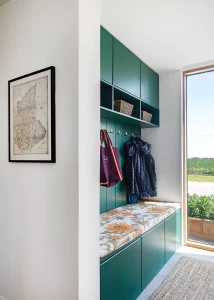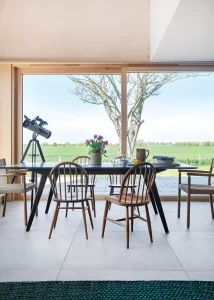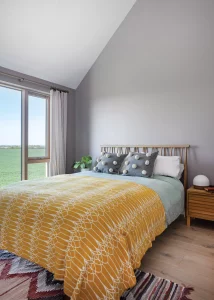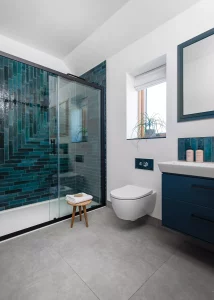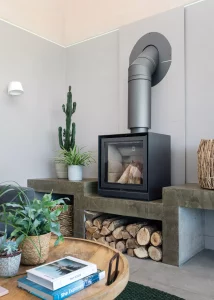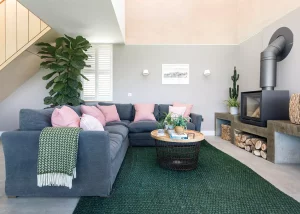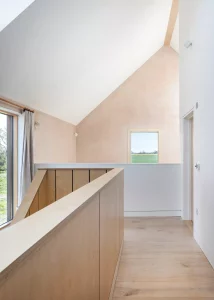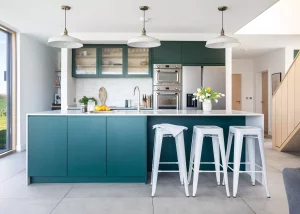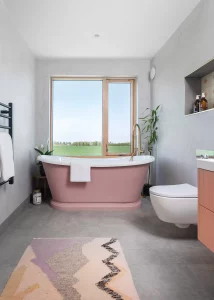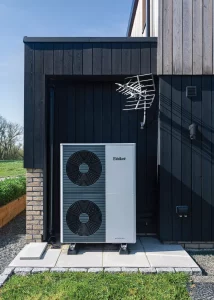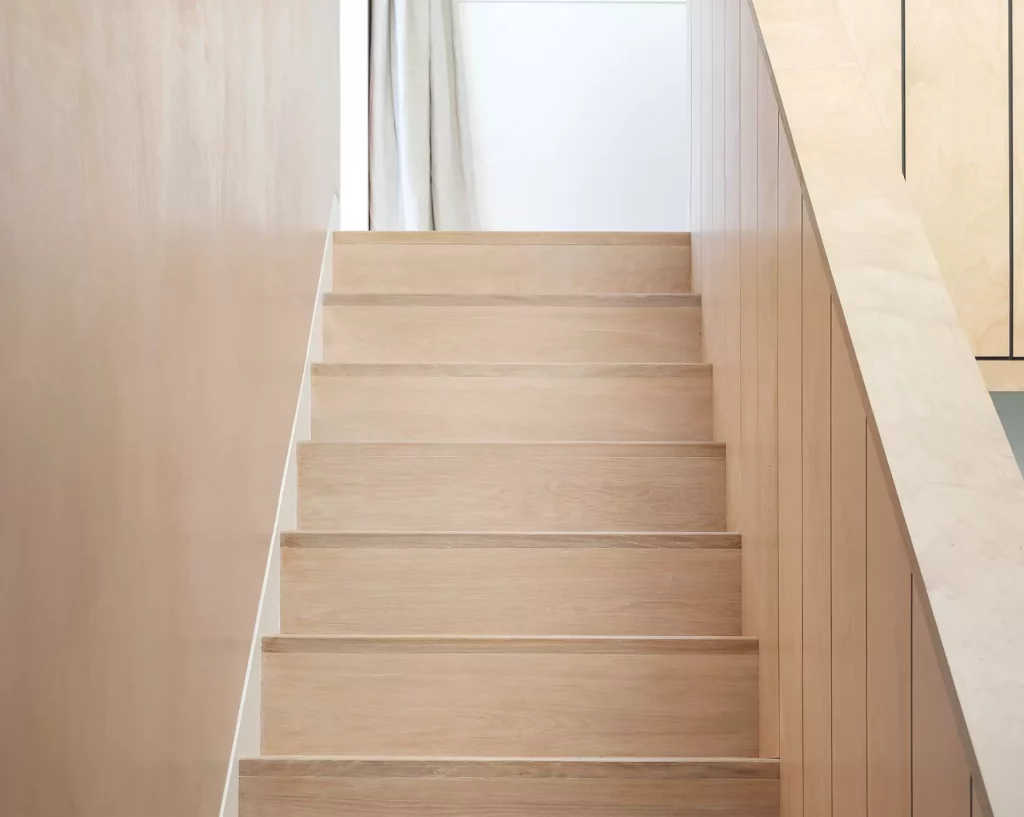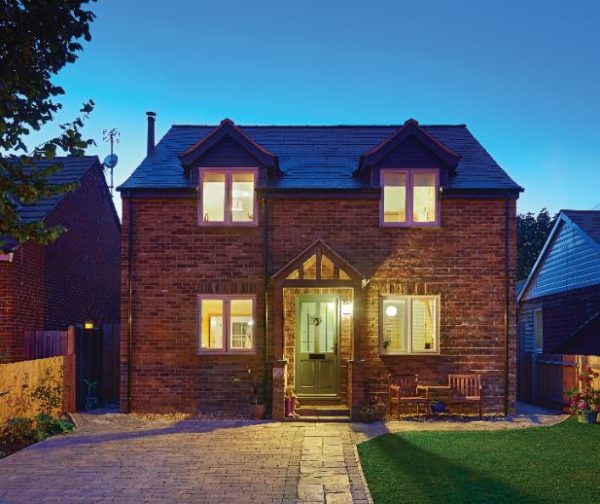Contemporary Self Build Home on Family Farm
Freddie had built his previous home, a compact cabin for him and his now-wife Katie, on his family’s farm on the eerily beautiful Romney Marsh in Kent. However, after a few years of saving, the couple decided they needed a new project and something a little roomier.
In 2018, the couple started looking at getting planning permission on another plot on the farm, just a few fields away.
“I would always drive past and think, ‘One day I am going to live on that plot.’ When you have got the access and the opportunities with family land, it’s the obvious decision,” says Freddie. “Otherwise, our budget would only have only afforded us a small terraced house.”
There was an existing property on the site already – a rather uninspiring detached 1950s brick house. The couple had looked at renovating, but quickly realised it would be more cost-effective to knock down and begin a new self build project, recreating the farm-style design with a modern twist.
Planning the Knock Down and Rebuild Project
The couple enlisted the help of Rob Pollard, of local practice RX Architects, to draw up plans. “The brief was to create an adaptable and practical country home. The design needed to suit Katie and Freddie’s lifestyle now, but also with the potential to adapt as they grow as a family”, says Rob.
“A boot room, utility space and office were all essential for them, but still keeping bright, open and fun internal main living spaces. The design also incorporated high levels of insulation, triple glazing and an air-source heat pump, resulting in a low-energy property with minimal long-term running costs.”
The design and planning process took 18 months and permission was granted to create a larch-clad detached dwelling alongside a garage/outbuilding. The tenants of the existing 1950s property vacated the house in December 2019, and work could begin.
- NAMESFreddie & Katie Pack
- OCCUPATIONSFarmer & medical sales
- LOCATIONKent
- TYPE OF PROJECTSelf build
- STYLEContemporary
- CONSTRUCTION METHODTimber & steel frame
- PROJECT ROUTECommissioned Architect & tendered to own builder contacts
- PLOT SIZE 0.5 acres
- LAND COSTAlready owned
- HOUSE SIZE175m2
- PROJECT COST £350,000
- PROJECT COST PER M2£2,000
- VAT RECLAIM£70,000
- BUILDING WORK COMMENCEDJuly 2020
- BUILDING WORK TOOK50 weeks
- CURRENT VALUE£800,000
Building a Home in Lockdown
Demolition took place over two weeks in April 2020, just as the world was floored by Covid-19.
Luckily, building work was allowed to continue in lockdown, but there was a lack of materials, including plaster and concrete, because plants were shut due to the pandemic.
Freddie, however, was one step ahead. “I anticipated the issues and established relationships with four building merchants,” he says.
“I was able to accrue stock gradually and in advance because there were limits on what you could buy at any one time.”
Read More: Buying Building Materials: Quantities, Quality & Lead Times
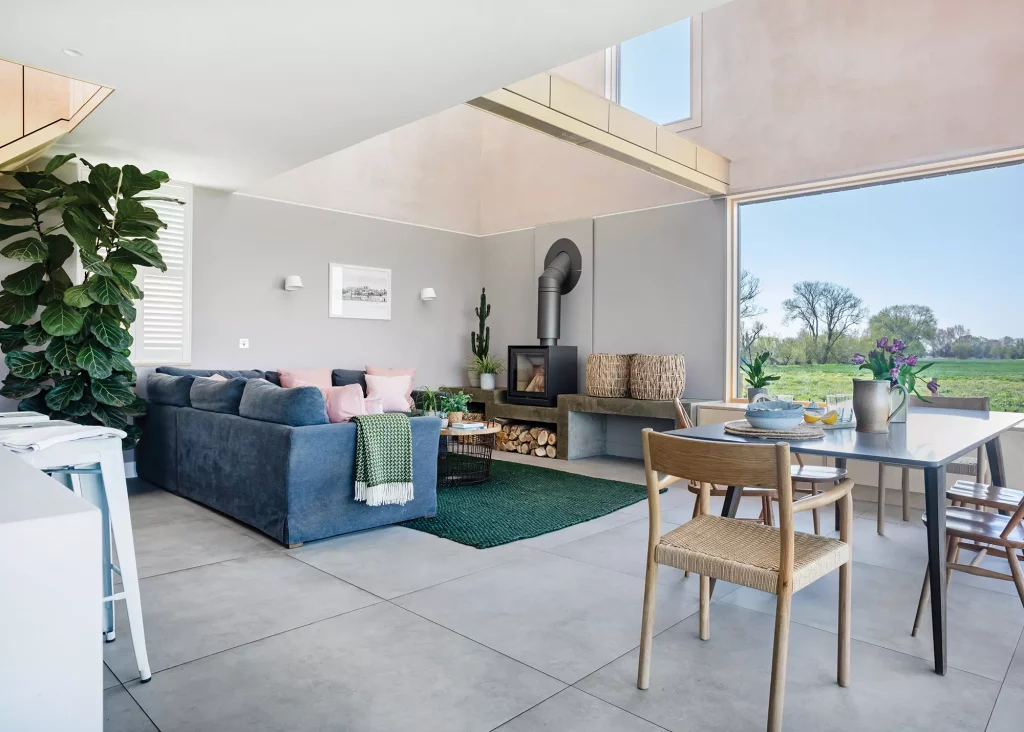
The living-dining area sits at the bottom of a double-height void, with sleek glazing that captures stunning views of the surrounding farmland
The couple continued living in the cabin while work was being done and Freddie was on site every day getting his hands dirty. Katie was an integral part of the process and they both agreed on the overall design.
This wasn’t always the case when it came to Freddie and his architect – a wrangling that is a normal part of the process.
“Rob said we should seek planning for the outbuilding as we would be likely get it. It was originally meant to be a flat-roof design but it looked like something you would land on Mars and I hated it,” says Freddie, “so I pushed for the A-frame shape.”
The seamed aluminium roof that is a feature of both buildings required a specialist. “I knew it would be quicker and cheaper to use slate but Rob told me not to as it wouldn’t look right,” says Freddie.
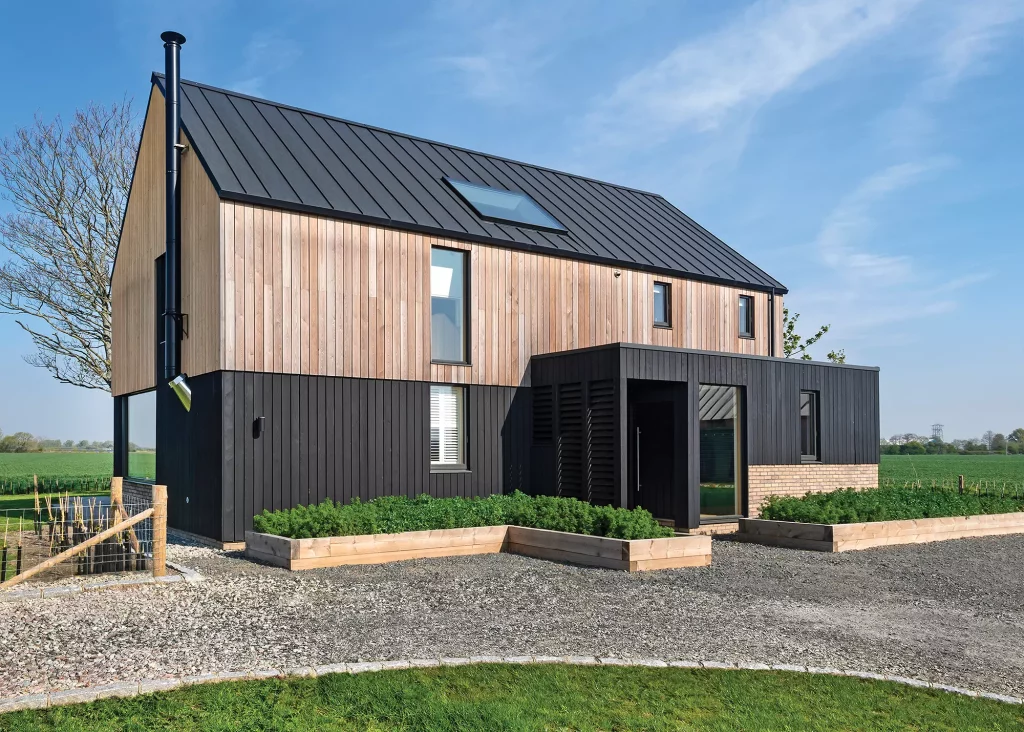
The property sits in the middle of Romney Marsh farmland; the elements will slowly turn the Siberian larch cladding a muted silver hue
The aluminium ended up costing £4,500 more, but Freddie is happy he was overruled on this occasion. “I knew that fitting in sub-contractors sometimes messes with the schedules and wanted to go with my tradesmen and a process I was familiar with – but I am really glad I listened to Rob, because it looks great,” he says.
Learn More: Complete Guide to Modern Roofing Materials
Dealing with Difficult Building Conditions
Freddie knew that the build would be his last bit of construction work before transitioning into a full-time role on the family farm alongside his mother, who still lives in the main farmhouse.
“It made a nice change running my own project and not having to deal with clients. I enjoyed being the one that had the final say,” he says.
However, there were a few bumps in the road. “On top of the issues with supplies, we got slapped with a lot of building conditions that we weren’t expecting; the council had sub-contracted out some of the planning and the company they used were very belt and braces,” says Freddie.
“For example, we had to commission an archaeological survey, which was frustrating as there had been a house on the plot previously. We also had to have an expensive contamination report and we had to lay a gas barrier down over the slab to ensure there was no leakage from the ground. It all seemed unnecessary.”
There was another hiccup when the telegraph pole that connected to the grid blew down because it was rotten. “We had no mains electrics on site for a few months and used generators,” says Freddie.
Designing a Home for Fuss-Free Living
Despite having issues with planning, Freddie says that the build wasn’t too stressful and that being in control of the ordering and budget meant he could anticipate where and when slip-ups might happen.
What’s more, he feels Covid worked in his favour when it came to labour. “In a way it helped being in lockdown – it meant that builders were on site all the time because they couldn’t go to the pub!”
The couple wanted open-plan and fuss-free living, and an end result that was economical to run. “The house is well insulated and we went beyond the Building Regulations, so bills are minimal,” says Freddie.
Read More: 12 Ways to Save on Home Energy Bills
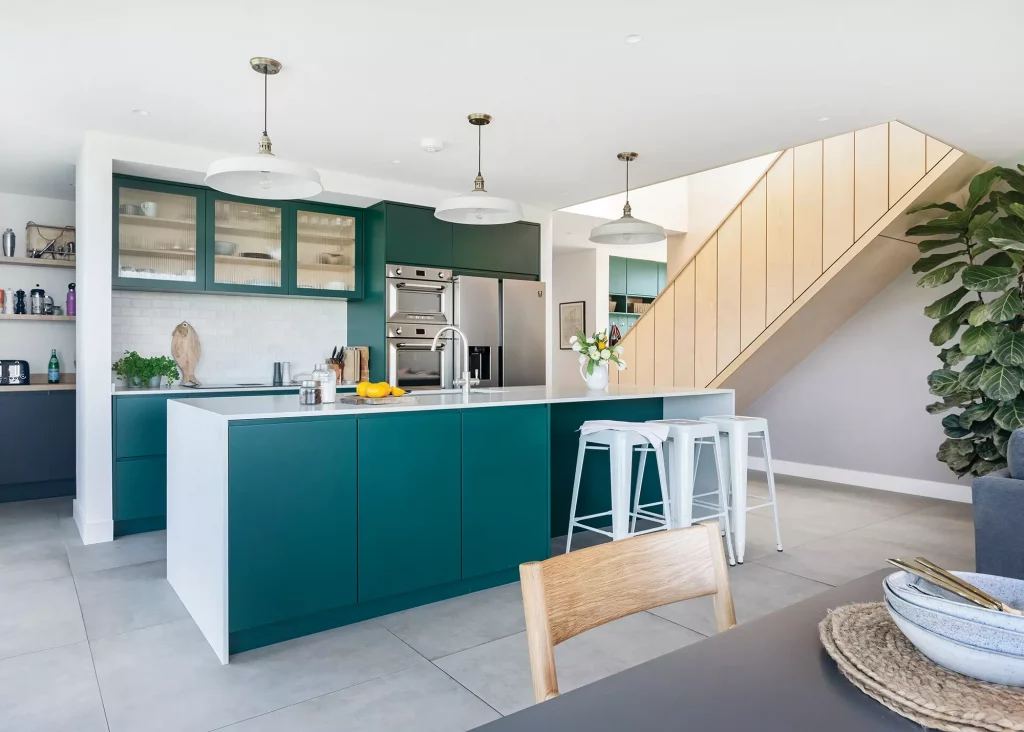
Dark teal handle-free units are crisply outlined with white tiles and worktops in the kitchen
A Siberian larch staircase is a focal point in the downstairs living space, while the open-plan area features a dark teal kitchen plus a dining and sitting area with a large void space above, finished in raw plaster with a beautiful pink hue.
A larder space, office, utility, WC and boot room then complete the layout downstairs. Large anti-slip ceramic tiles cover the floor, but Freddie regrets this choice. “The textured tile is hard to clean, which makes it tricky with our dogs, Dylan and Bean,” he says.
“What’s more, as the tiles are so big the screed needed to be super flat – there are a few hollow sections, which grates on me!”
Read More: Complete Guide to Flooring for your Home
CLOSER LOOK Raw TonesThe minimalist style of the staircase and plaster walls give a natural feel to the open-plan living space, and the flight is a great focal point on entering the house. “It has a large landing and great views,” says Freddie. “It is a real luxury because it takes away a lot of floor space, but it was a feature that we really wanted.” The couple’s architect suggested the raw plaster finish and they are delighted with the result. “It is a nice tone and there was a cost saving because we didn’t have to paint it,” says Freddie. |
Upstairs there is a master bedroom with ensuite shower room and walk-in wardrobe, plus a second bedroom and main bathroom featuring a candy-pink bateau bath.
The landing overlooks the void space, but there is always the option to build more bedrooms should the need arise. And, this could well be the case in the near future, as the couple are expecting their first child in October.
Katie’s vision really came into play in terms of specifying an elegant and refined theme for the interiors. “She is very good at making decisions,” says Freddie.
Completing the Build
The project came in pretty much on budget, with the only overspend being on the garage because they hadn’t anticipated constructing it straight away.
Insuring the build was straightforward too, because they tied it into the existing NFU farm policy.
Outside, the property is clad in Siberian larch, with charred sections on the lower level. “I was used to working with larch and we went for shadow gaps rather than rebating. We had to put a black felt wrap on the exterior, followed by batons, a double skin of UV facade felt and then the cladding,” he adds.
Read More: 5 Different Types of Timber Cladding
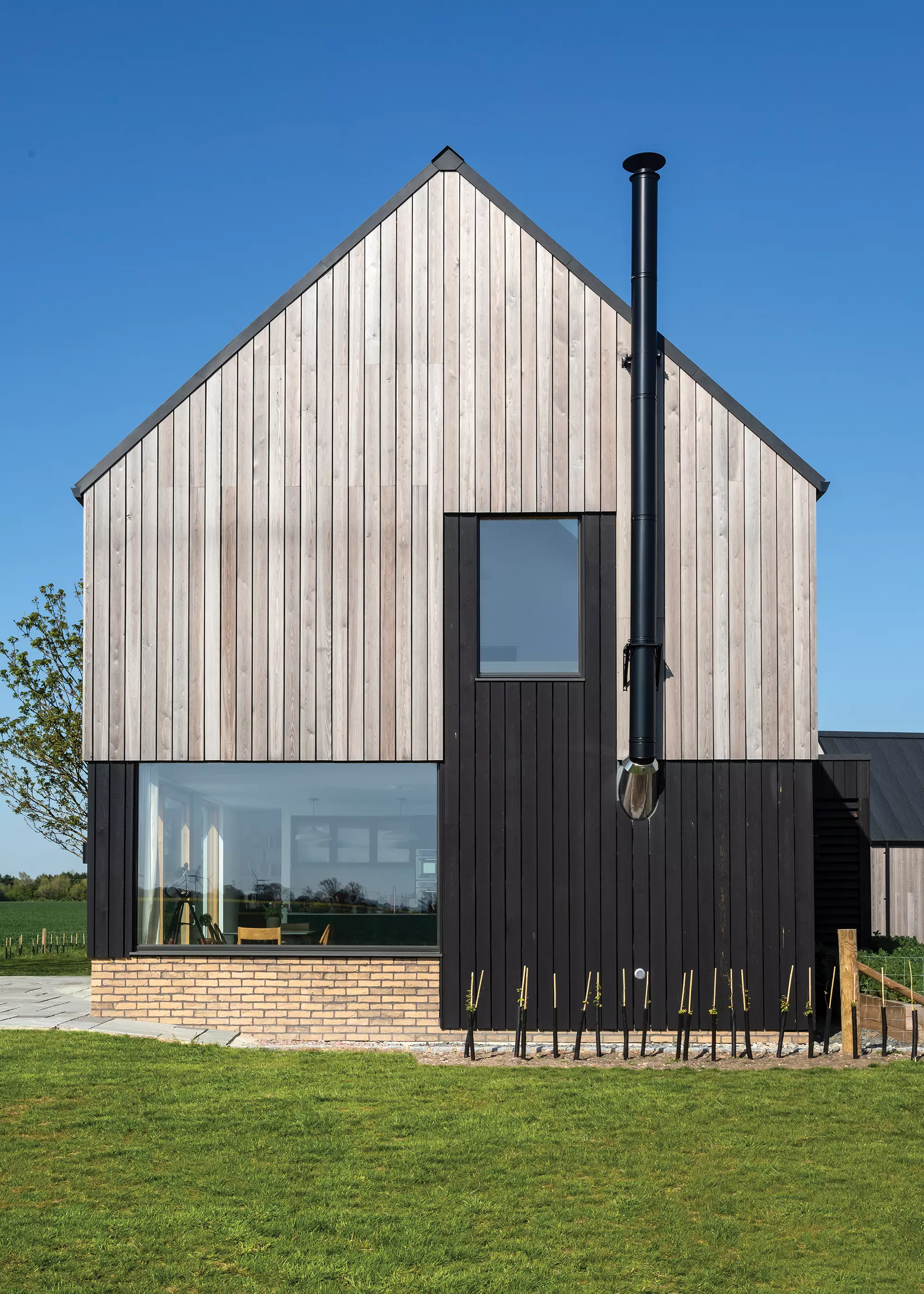
The Siberian larch cladding makes a clean and sophisticated addition to the property’s finish
The foundations posed a problem because the marsh landscape the farm renovation has been built upon is comprised of so much sand. “We had to use steel rods and fill them with concrete but actually it was pretty straightforward in the end,” says Freddie.
When it came to the garden and landscaping, Freddie admits it was a bit of an afterthought so it is still a work in progress. “I was so focused on the house that I didn’t give it too much thought,” he says.
Meanwhile, there was meant to be a cantilevered flat roof over the front door, but it was just too windy when the door was open and so it would slam. “We ended up putting on a louvered shuttered wall to shelter it from the wind and created a porch,” says Freddie.
Work took just under a year and the couple were able to move in July of 2021, shortly before their wedding.
Overall, they are delighted with the result, but Freddie is reluctant to give himself too much of a pat on the back. “There is always room for improvement isn’t there,” he says. “Hindsight is a powerful thing!”
Looking for cladding ideas? Read our guide on Mixing Different Types of Wall Cladding
We Learned…
|
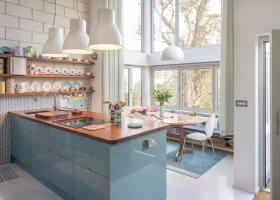
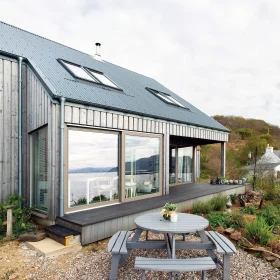






























































































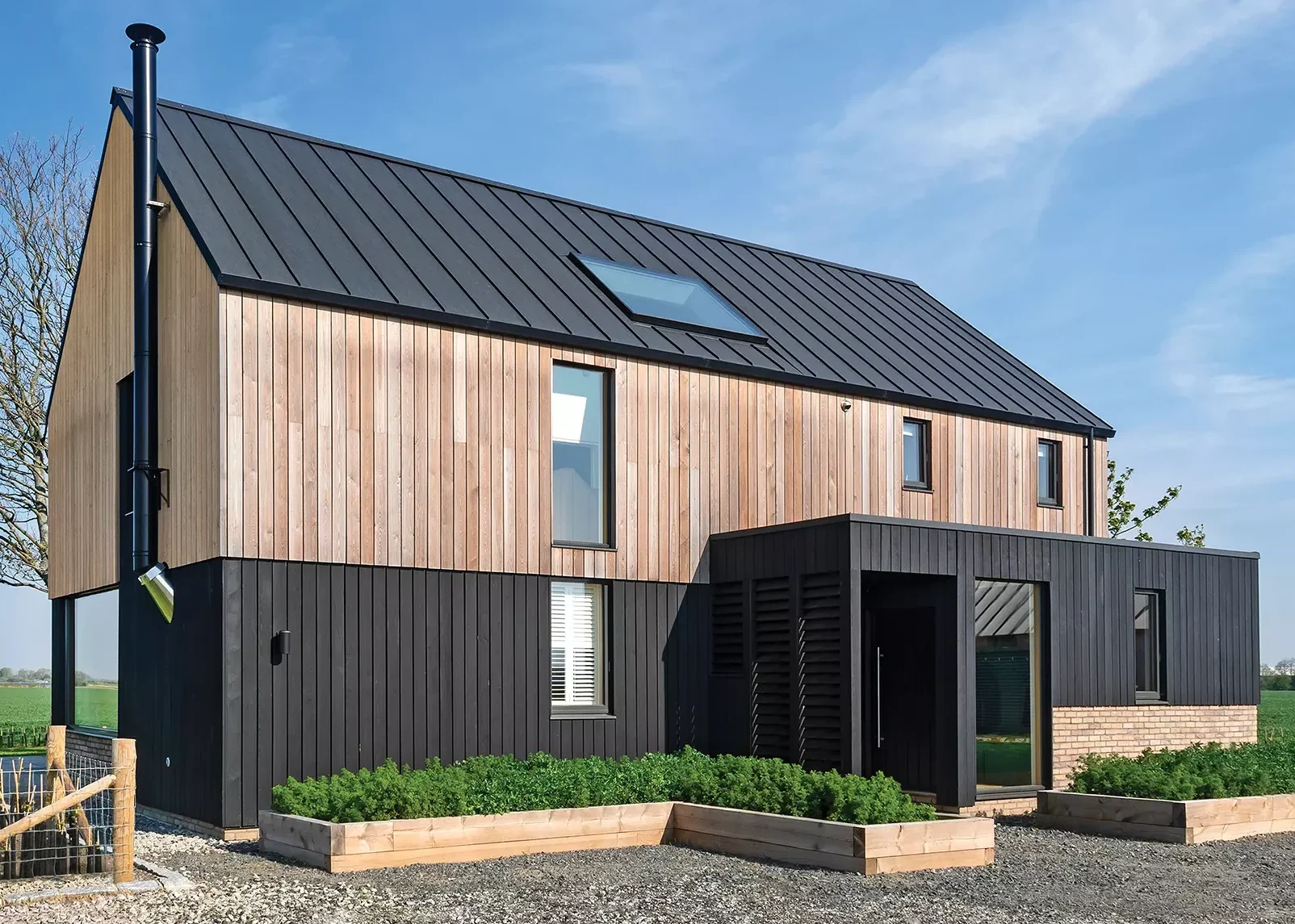
 Login/register to save Article for later
Login/register to save Article for later

